
a web page by Don Roberson |
VIREOS & ALLIES Vireonidae |
||
|
||
Most American birdwatchers have not figured this out. They think of vireos and warblers as similar — in fact, the two were considered closely related before molecular evidence changed the entire picture. New World warblers are among the Passerida assemblage and not remotely related to vireos. Vireos are members of the Corvida; they are closely related to crows and shrikes. We first learned this through the DNA-DNA hybridization research by Sibley & Ahlquist (1990). |
||
 |
||
Yellow-green Vireo is a widespread vireo in Central America (Mexico to Panama) and winters to western South America. At one time a few bred in southernmost Texas, but now the species is found in the United States only as a vagrant. A tiny handful apparently fly the "wrong way" (north instead of south) in fall migration and appear as vagrant. The one shown here (above) was in coastal Monterey County in late September — the prime time for these vagrants. It remained locally for almost a week and drew birders from across the State to see it. Red-eyed Vireo plays a dominant part in the aural landscape of the eastern North American deciduous woodlands. To quote from Bent (1950): "The Red-eyed Vireo is preeminently famous as a singer. No other of our birds sings so persistently all day long, and because his long-continued series of utterances, given in short, emphatic, phrases, going on for hours, calls to mind a lengthy sermon, he has won the title of 'Preacher'. ... Nevertheless the preacher sings a cheerful song.... We might suppose him to be repeating moderately, with a pause between each sentence, 'You see it, you know it, do you hear me? do you believe it?' All these strains are delivered with a rising inflection at the close, an with a pause, as if waiting for an answer." Birds in the old "Solitary Vireo" set — now split geographically as Cassin's Vireo (western; photo at top of this page), Plumbeous Vireo V. plumbeus (Great Basin), and Blue-headed Vireo V. solitarius (eastern) — sings an even more dramatic 'question-and-answer' series of melodic phrase that might be rendered: "See me? [pause] I see you [pause] cheerio [pause] be seeing you? [pause] so long." Bent (1950) quotes an old-timer as stating that "on the whole it is the most pleasing of the vireo songs." All the large vireos can be very difficult to spot among the canopy of a fully-leafed-out deciduous tree. All are migratory, with North American breeders wintering in the Neotropics. |
||
Vireos are predators on invertebrates, and consume a wide variety of spiders, beetles, wasps, and other insects throughout the year, taken mostly from the bark and foliage (Brewer & Orenstein 2010). In the southeastern U.S., the widespread small vireo is White-eyed Vireo (below left). It is difficult to spot among a dense understory, but its oft-given rapid, nasal, harsh song, beginning or ending with 'chik' notes, gives it away. The inconspicuous small vireo of oak-juniper scrub in central Texas and Oklahoma is the striking Black-capped Vireo (below left, an adult on nest taken by Greg W. Lasley). It is an endangered species and highly sought by American birders. |
||
|
||
Local birders are also interested in vireos as migrants, because migrants can go the wrong direction and turn up as exciting vagrants. For example, this Yellow-throated Vireo (right) of eastern North America was at a 'vagrant trap' on the coast of Monterey County, California, and virtually all of the local birders came to chase it. While many North American vireos migrate to the Caribbean, or Central America, or South America for the winter, there are a fair number of resident members of the Vireonidae that are not in genus Vireo. The gallery of four photos below focus on those tropical members of the family, traditionally known as the peppershrikes, the shrike-vireos, and the greenlets. |
||
|
||
There are four species of shrike-vireos in genus Vireolanius. These are probably the most colorful and striking members of the Vireonidae. Although they are not rare they are just very elusive. In my Neotropic experience, it has always taken a very long time to track down a singing shrike-vireo. Of course I come from the birding era before the use of tapes was common, and perhaps things have changed, but to see any of the shrike-vireos was considered a major accomplishment. Chestnut-sided Shrike-Vireo (above left, in a shot by Magnus Manske) is endemic to Mexico and Guatemala, where it occurs in humid to semi-arid scrub and forest at mid-elevations in rugged terrain. It is the most distinctive of the shrike-vireos. The remaining three are bright green or green-and-yellow canopy birds of tropical forests. Green Shrike-Vireo V. pulchellus is mostly lowlands in Central America, Yellow-browed Shrike-Vireo is a foothill bird in northwest South America, and Slaty-capped Shrike-Vireo (above right, in a shot by Hector Bottai) is a foothill and lower montane species patchily distributed across a good portion of northern South America. Learning the distinctive calls of these species is the key to finding them — and they can certainly dazzle the observer once discovered. There are two peppershrikes: on very widespread in the Neotropics [Rufous-browed Peppershrike, below left, in a shot by Arthur Grosset] and the other local at mid-elevations in the Andes [Black-billed Peppershrike C. nigrirostris]. Like shrike-vireos they are hard to spot in the canopy of tropical trees but the song of Rufous-browed Peppershrike — a short melodious warbler sometimes transcribed as "do you wash every week?" — is often among the background cacophony in the Neotropical lowlands. It is well adapted to forest edges and thus is common near towns and villages. The peppershrikes are considered the basal clade among the Vireonidae (Brewer & Orenstein 2010, Slager et al. 2015). Finally, there are about 15 species of greenlets, represented here by the Rufous-crowned Greenlet of coastal southeastern Brazil (below right, in a shot by Hector Bottai). Greenlets thrive in a variety of wooded habitats and are often among mixed foraging parties. New research (Slager et al. (2015, discussed further below) suggests that the set should be placed in three genera, rather than the single genus Hylophilus, as is the traditional approach. |
||
|
||
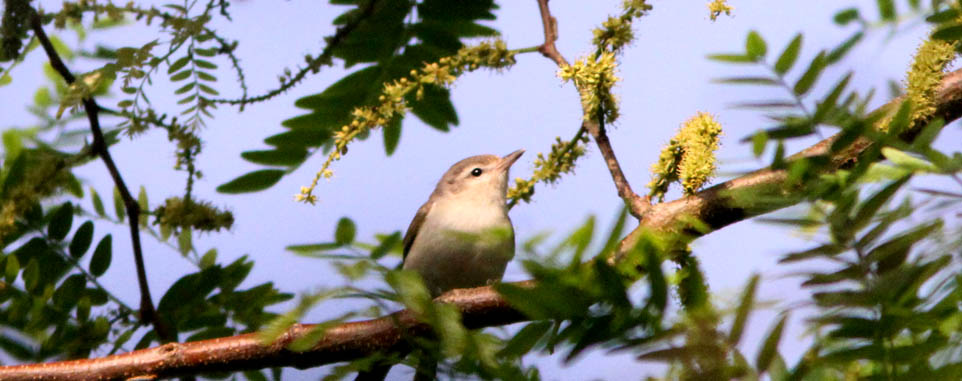 |
||
The new evidence will be cited as support for various future splits in this family. Among then is a potential split in Warbling Vireo: splitting Eastern Warbling-Vireo V. gilvus (shown above) from Western Warbling-Vireo V. swainsoni (left). There may also be splits proposed for Red-eyed Vireo, separating the migratory North American Red-eyes from the resident Red-eyes of the Neotropics (Chivi Vireo?). This will all be worked out by the South American and North America checklist committees. As they say, stay tuned.
|
||
The Erpornis and Shrike-babblers are now often placed in Family Vireonidae by some global checklists. However, Jønsson et al. (2016) found that Shrike-babblers had evolved on their own for more than 23 million years (their proposed 'cut-off' point for families in the Corvida) so they elevated Shrike-babblers to Family status. The kept Erpornis, which is still an ancient clade at 20 mya, with the Vireos. I am of the opinion that 'cut-off' lines on an evolutionary scale should be flexible and not fixed (i.e., we know different types of vertebrates, including different types of birds, evolve at different rates). I prefer to maintain both the Shrike-babblers and the Erpornis as separate Families. I suspect we will get more help on this topic in future research. |
||
Photos: The Cassin's Vireo Vireo cassinii was at Sardine Lake, Sierra Co., California, on 27 June 2015. Bill Hill photographed the Yellow-green Vireo V. flavoviridis at Laguna Grande Park, Monterey Co., California, on 29 Sep 2015, and I photographed the adult Red-eyed Vireo V. olivaceus there the same day; both were vagrants at the locale. The Hutton's Vireo V. huttoni was at Big Sur R. mouth, Monterey Co., on 20 June 2015. 24 May 2013. The singing White-eyed Vireo V. griseus was at Cedar Mountain battlefield, Virginia, on 24 May 2013. Greg W. Lasley photographed the nesting Black-capped Vireo V. atricapilla in Williamson Co., Texas, on 24 June 1990. The Yellow-throated Vireo V. flavifrons was at Big Sur R. mouth, Monterey Co., California, on 23 May 2004. Magnus Manske photographed the Chestnut-sided Shrike-Vireo Vireolanius melitophrys near Lake Atitlán, Guatemala, on 24 Apr 2011. Hector Bottai photographed the Slaty-capped Shrike-Vireo Vireolanius leucotis at Apiacás, Brazil, on 17 Nov 2013. Arthur Grosset photographed the Rufous-browed Peppershrike Cyclarhis gujanensis at Manaus, Brazil. Hector Bottai photographed the Rufous-crowned Greenlet Hylophilus poicilotis at São Luizdo, Paraitinga, Brazil in March 2013. In pending future possible splits, the Eastern Warbling-Vireo Vireo gilvus was at High Island, Texas, on 28 Apr 2014, and the Western Warbling-Vireo V. swainsoni was at Laguna Grande Park, Seaside, California, on 6 Dec 2015. The Erpornis Erpornis zantholeuca was at Khao Yai NP, Thailand, on 25 Dec 2012. Uncredited photos © Don Roberson. Credited photos © Bill Hill, © Greg W. Lasley, and © Arthur Grosset, as credited, and used with permission; and credited photos © Magnus Manske and © Hector Bottai, are licensed for use, with credit, through Wikipedia Commons; all rights reserved. Bibliographic note: There is no "family book" per se, but a fine introduction to this family, with excellent photos, is in Brewer & Orenstein (2010). Literature cited:
|
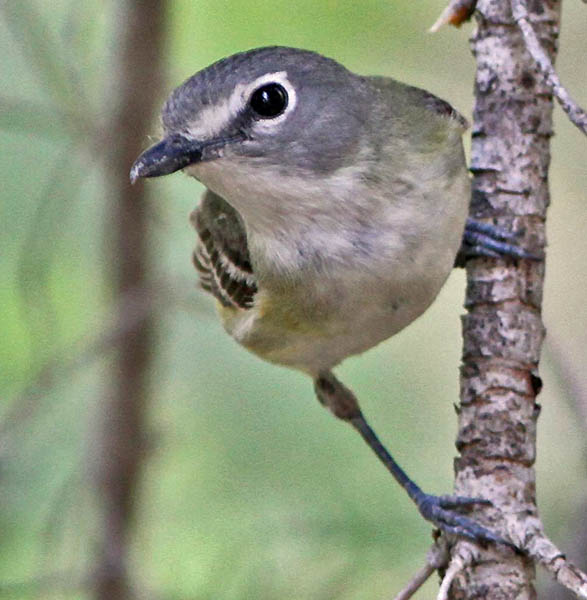 The
Vireonidae is a fairly large family of small, arboreal New World
passerines. Many small tree-loving birds are frenetic, or colorful, or
dainty — but vireos, despite their small size, are "muscular." Consider
this Cassin's Vireo (left), a breeding bird of mixed
woodlands in the foothills and mountains of western North America. A
standard American field guide — let's just check the National Geographic guide — says it is 5 inches long. Exact same size given for, say, the widespread Yellow Warbler Setophaga petechia.
But look at the vireo's long and sturdy legs, its huge feet, its
hook-tipped bill, its broad chest — the vireo is nothing like the
dainty warbler. In anthropomorphic terns, the vireo would be the bully
on the beach kicking sand in the face of the Yellow Warbler wimp. If
vireos were in the Old World, they'd fill the Babbler niche.
The
Vireonidae is a fairly large family of small, arboreal New World
passerines. Many small tree-loving birds are frenetic, or colorful, or
dainty — but vireos, despite their small size, are "muscular." Consider
this Cassin's Vireo (left), a breeding bird of mixed
woodlands in the foothills and mountains of western North America. A
standard American field guide — let's just check the National Geographic guide — says it is 5 inches long. Exact same size given for, say, the widespread Yellow Warbler Setophaga petechia.
But look at the vireo's long and sturdy legs, its huge feet, its
hook-tipped bill, its broad chest — the vireo is nothing like the
dainty warbler. In anthropomorphic terns, the vireo would be the bully
on the beach kicking sand in the face of the Yellow Warbler wimp. If
vireos were in the Old World, they'd fill the Babbler niche. 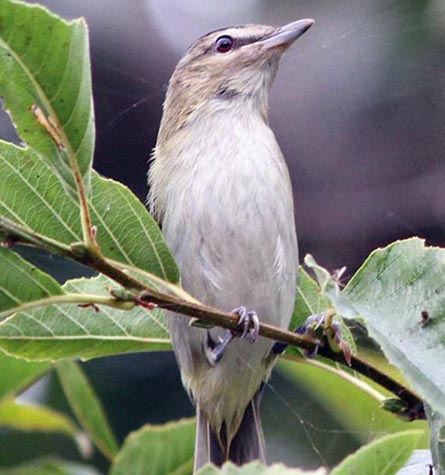 Vireos
do have a size range from "small vireos" to "large vireos," but we're
talking the difference between 4 inches and 6.5 inches in length, or
comparing a bird weighing 8 grams to a large vireo at 18 grams (to
quote stats from Sibley 2000). Cassin's Vireo is a mid-sized vireo. The
"large" vireos in North America include Yellow-green Vireo (above, a very nice photo by Bill Hill) and Red-eyed Vireo (right).
Vireos
do have a size range from "small vireos" to "large vireos," but we're
talking the difference between 4 inches and 6.5 inches in length, or
comparing a bird weighing 8 grams to a large vireo at 18 grams (to
quote stats from Sibley 2000). Cassin's Vireo is a mid-sized vireo. The
"large" vireos in North America include Yellow-green Vireo (above, a very nice photo by Bill Hill) and Red-eyed Vireo (right). 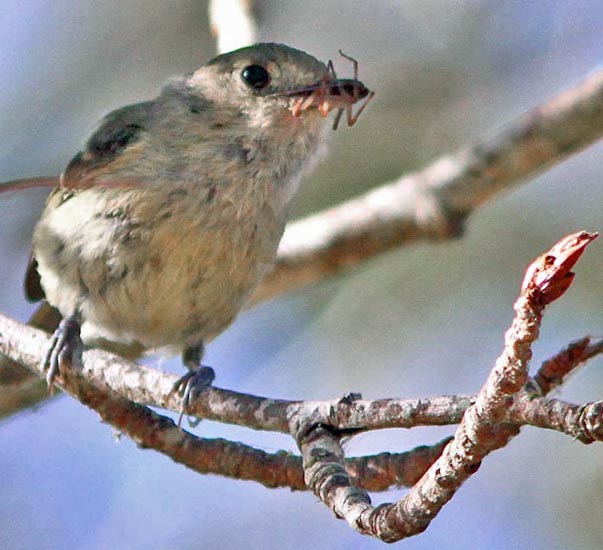 The small vireos can be equally inconspicuous unless they are heard. Hutton's Vireo
(left, here carrying a spider to young at its nest) lives in my
backyard all year, but is always unobtrusive. Only in spring — when the
male sings its monotonous upslurred short phrase all day long zwee!
zwee! zwee! — is its presence easily recognized.
The small vireos can be equally inconspicuous unless they are heard. Hutton's Vireo
(left, here carrying a spider to young at its nest) lives in my
backyard all year, but is always unobtrusive. Only in spring — when the
male sings its monotonous upslurred short phrase all day long zwee!
zwee! zwee! — is its presence easily recognized.
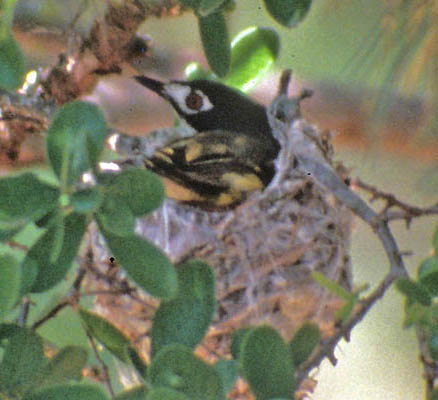
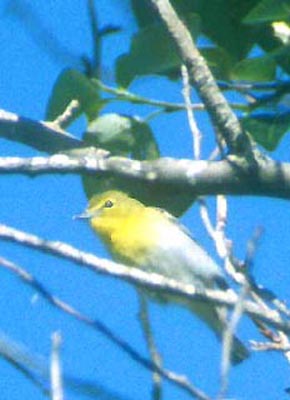 A variety of vireos are local, threatened, or endangered. In California, the western pusillus race of Bell's Vireo V. belli
[Least Bell's Vireo, which may possibly warrant species status someday]
almost disappeared but has made modest comebacks with riparian habitat
restoration and active cowbird control in some locations. The parasitic
Brown-headed Cowbird lays its eggs in the open cup nests of vireos, and
the vireos accept the young as their own. Riparian habitat, and
especially coastal riparian habitats, have been fragmented or lost to
development. Cowbirds can more easily find vireo nests when such
habitat is patchy, with lots of edges. I fear that our tiny local
population of Least Bell's Vireo in Monterey County is gone.
A variety of vireos are local, threatened, or endangered. In California, the western pusillus race of Bell's Vireo V. belli
[Least Bell's Vireo, which may possibly warrant species status someday]
almost disappeared but has made modest comebacks with riparian habitat
restoration and active cowbird control in some locations. The parasitic
Brown-headed Cowbird lays its eggs in the open cup nests of vireos, and
the vireos accept the young as their own. Riparian habitat, and
especially coastal riparian habitats, have been fragmented or lost to
development. Cowbirds can more easily find vireo nests when such
habitat is patchy, with lots of edges. I fear that our tiny local
population of Least Bell's Vireo in Monterey County is gone.
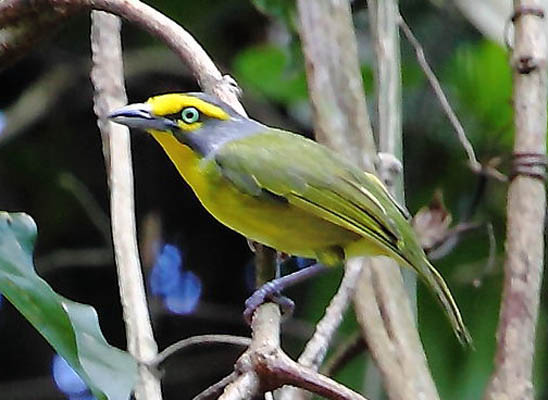


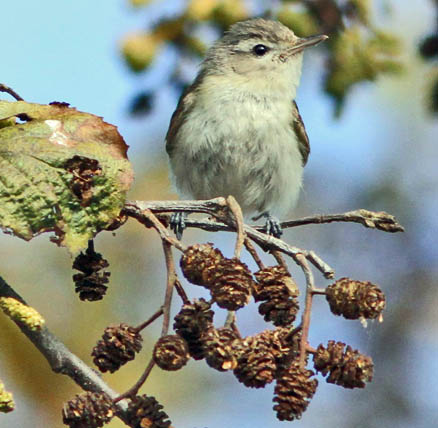 There
are likely to be taxonomic changes in the Vireonidae in the near
future. Slager et al. (2015) obtained molecular evidence for most taxa.
They suggest that the genus Hylophilus (greenlets) is polyphyletic and suggest a 3-way generic split. They also propose to move Tepui "Greenlet" to Vireo (becoming Tepui Vireo V. sclateri?) while the Golden V. hypochrysea of central Mexico is apparently a greenlet in genus Pachysylvia.
There
are likely to be taxonomic changes in the Vireonidae in the near
future. Slager et al. (2015) obtained molecular evidence for most taxa.
They suggest that the genus Hylophilus (greenlets) is polyphyletic and suggest a 3-way generic split. They also propose to move Tepui "Greenlet" to Vireo (becoming Tepui Vireo V. sclateri?) while the Golden V. hypochrysea of central Mexico is apparently a greenlet in genus Pachysylvia. 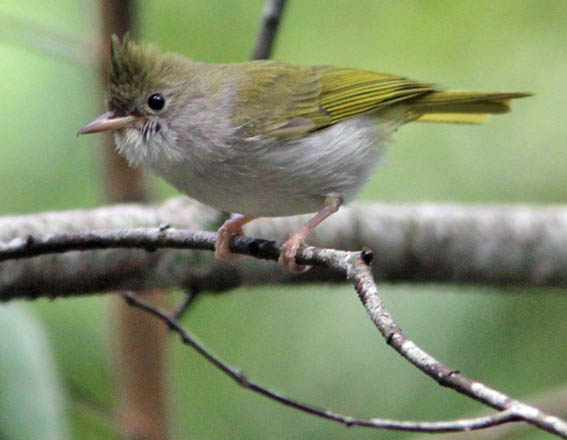 Finally,
it should be mentioned that genetic evidence has shown that several
"babblers" in Asia are more closely related to Vireos than to another
other birds. The "White-bellied Yuhina Y. zantholeuca" and Shrike-babblers (Pteruthius) proved to be more closely related to New World vireos than any Old World families (Cibois 2003, Alström
et al. 2006, Reddy 2008). The "Yuhina" is now called simply Erpornis Erpornis zantholeuca (photo right) and of the Old World birds, it is the one that is most closely related to Vireos.
Finally,
it should be mentioned that genetic evidence has shown that several
"babblers" in Asia are more closely related to Vireos than to another
other birds. The "White-bellied Yuhina Y. zantholeuca" and Shrike-babblers (Pteruthius) proved to be more closely related to New World vireos than any Old World families (Cibois 2003, Alström
et al. 2006, Reddy 2008). The "Yuhina" is now called simply Erpornis Erpornis zantholeuca (photo right) and of the Old World birds, it is the one that is most closely related to Vireos.